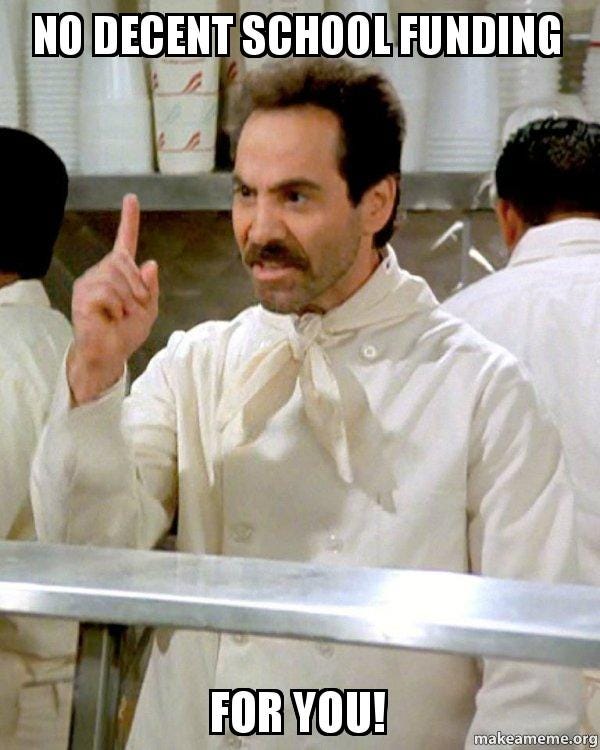The Daily Agenda: How much slack are taxpayers picking up?
Pima County schools put bonds on the ballot .... Not a lot of luck in the past ... Hottest month on record.
It’s back-to-school week, and with tens of thousands of students and teachers heading back into classrooms across Pima County.
With education on the brain and the primary election in our rearview mirror, we decided to look ahead to November’s election and what that means for Southern Arizona schools.
We wrote last week about school vouchers and the estimated $943 million the state will spend on them this school year. That’s a lot of money, and schools in Pima County, and everywhere else in Arizona, sure could use it. But instead, public schools have to ask voters to approve bonds and overrides for much-needed funds.
Five local school districts are asking Pima County voters to approve six bond and override questions in November, with the deadline for submitting arguments for or against each rapidly approaching.
Between the five districts, we’re talking about at least $550 million in funding, which begs the question, just how much slack are local taxpayers picking up when it comes to funding education?
A 2021 report by the Education Law Center showed that Arizona ranked dead last in the nation for educational spending in 2019, with the state contributing 37% fewer dollars per student than the national average of $15,487.
That’s a lot of slack.
The Tucson Unified School District is seeking the most taxpayer assistance this year, with two override questions on the ballot, but Sunnyside, Flowing Wells, Sahuarita and Altar Valley are also asking voters for help.
The district governing boards and residents have until next Friday to submit arguments to the Pima County Schools Superintendent, who will be preparing pamphlets that will be mailed to voters.
But that’s still weeks away, so while we’re waiting on the official pros and cons for each proposal, let’s take a look at what’s at stake.
Prop. 496, Tucson Unified School District
How much money would Prop 496 generate? The proposal is for a $480 million bond package.
How much would it cost taxpayers? The median assessed value of a single family home in north central Tucson is $206,921, according to the Pima County Assessor’s Office. The override would add $0.69 per $100 to the tax assessment of the home, which would be roughly $1,428. With the 10% tax rate applied, the total amount residents in that home would pay each year is about $143.
How would the district use the money? The funding will go towards updates and renovations to aging schools, additional security measures and upgraded technology for every student. The district published a 92-page “bond book” detailing the proposal and how the money will be allocated to each school. The bond would pay for improvements like replacing roofs and air conditioning units, installing fencing, renovating fine arts spaces and modernizing science lab and career training spaces.
Why are they asking for so much money? TUSD is comprised of 88 school buildings that are an average age of 55 years, but the oldest building is more than 100 years old. The district is responsible for the maintenance of more than 9 million square feet of buildings, and the bond book provides detailed spending proposals for each school.
How did past override efforts go? The last time voters approved a TUSD bond was 20 years ago and in the last 15 years, TUSD was hit with $161.1 million in state capital funding cuts. The district’s last proposed bond package, a $180 million plan back in 2017, was easily defeated by a margin of 59% to 41%, Hank reported for the Arizona Daily Star at the time.
Every day is a bond election for us. We’re working hard to earn your vote (ahem, paid subscription) and we’re not asking for anywhere near $480 million. Although, if you’re offering, we certainly wouldn’t say no to it.
Prop. 498 and Prop. 499, Sunnyside Unified School District
How much money would Prop 498 generate? The 8% maintenance and operations budget override is expected to bring in $8.1 million over the next seven years. Overrides allow schools to exceed the state’s budget limits.
How much would it cost taxpayers? An anticipated annual tax assessment of $1.36 per $100. That’s means a taxpayer with a $200,000 home would pay about $270 more per year in additional taxes.
How would the district use the money? The district will use the money for school safety and security measures; to fund jobs that directly support academic growth and strengthen programs that prepare students for college or the workforce; fine arts and athletic programs; increased wages for teachers and staff and maintaining the ability to offer competitive salaries.
What happens if the override fails? The district would face budget cuts of roughly $8 million, which would cause a reduction or elimination of services and salaries, according to the district’s website
With Prop. 499, the district is seeking to exceed its district additional assistance budget.
How much money would Prop 499 generate? Either $7 million or 10% of its revenue control limit, whichever is less.
How much would it cost the taxpayer? The estimated first year tax rate for the override is $1.18 per $100 of secondary assessed valuation. District materials show that with an estimated average home value of $100,210, the annual impact on the average household would be $136 for Prop. 498 and $120 for Prop. 499.
How would the district use the money? Sunnyside would use the funding for safety and security improvements and the modernization of aging school buildings; maintaining athletic fields and fine arts facilities; updating classroom technology, curriculum, furniture and equipment; and new school buses and service vehicles.
What happens if it fails? The district won’t have enough funding to maintain an updated fleet service, purchase new equipment to support learning and make infrastructure improvements to keep facilities safe and modern.
How did past override efforts go? In 2019, district voters rejected a 10% maintenance and operations override by a vote of 53.4% to 46.6%. That override, which was the seventh that Sunnyside voters had rejected since 2011, would have raised $9.3 million annually, the Star’s Danyelle Khmara reported at the time.
Prop. 497, Flowing Wells Unified School District
How much money would Prop 497 generate? The 13% maintenance and operations budget override would bring in an estimated value of $4.8 million for the first year.
How much would it cost the taxpayer? The estimated cost to taxpayers is $2.04 per $100 of secondary assessed valuation. For a home assessed at $100,000, that means about $200 per year.
How would the district use the money? We weren’t able to find details about what that money would fund, but we’ll keep looking and report back.
How did past override efforts go? In 2019, voters approved the continuation of an override put in place in 1997 which raised about $3.1 million annually for fine arts, physical education, all-day kindergarten and after-school athletic programs and more, Khmara wrote in the Star.

Prop. 401, Sahuarita Unified School District
How much money would Prop 401 generate? The proposed bond would bring in an estimated $50 million in funding.
How much would it cost the taxpayer? The anticipated cost to taxpayers is $0.81 per $100 of secondary assessed valuation, or about $80 per year on a home appraised at $100,000.
How would the district use the money? The average school building is 30 years old, with the oldest at about 55 years old. The bond funding would allow the district to accommodate growth and shift its infrastructure to 21st century education and security. The revenue would also allow the district to address facilities management issues, while improving classrooms and outdoor facilities, adding security, expanding special programming and replacing aging furniture and equipment.
What’s next? The district is hosting a community conversation on August 30 to discuss its 2023 Bond for Future Ready Schools plan.
Prop. 400, Altar Valley Elementary School District
How much money would Prop 400 generate? The 10% maintenance and operations budget override will generate an anticipated $520,584 in revenue in the first year.
How much would it cost the taxpayer? The anticipated annual tax rate is $0.88 per $100, which is the same as the current tax rate for the existing budget override. So voters would see no increase.
How would the district use the money? We couldn’t track down details about the override, but we’ll report back on what we learn.
How did past override efforts go? District voters last approved an override, also for $10 million, in 2019 by a vote of 53.7% to 46.3%, KGUN9 reported at the time.
Gracious exit: City Council hopeful Miguel Ortega conceded to City Council Member Lane Santa Cruz in the Democratic primary for the city council seat in Ward 1, the Arizona Daily Star's Nicole Ludden reports. Unofficial results from Tuesday showed Santa Cruz got 63% of the vote. Ortega pointed to Santa Cruz raising far more funds than his campaign did.
Deadline approaching: The Pima County jail’s Blue Ribbon Commission is nearing the deadline for its recommendations on whether the facility can be improved or a new one needs to be built, the Arizona Republic’s Sarah Lapidus reports. The group will hear community input on its initial findings at its August 10 meeting. In September, it will develop final recommendations to supervisors. Pima County Board of Supervisors chair Adelita Grijalva said last month that the board would hold a study session before voting on the new jail.
One for the record books: With triple-digit high temperatures recorded every day in July, Tucsonans just endured the city’s hottest month since 1895, the Star reports. The monthly average temperature of 94.2 degrees was 6 degrees above normal, blowing away the previous July record of 91.5 degrees in 2020. August 2020’s 92-degree average was previously the hottest single month, according to the National Weather Service.
All sizzle, no steak: This year's legislative session was big on drama, but light on substance, the Arizona Mirror's Jerod MacDonald-Evoy reports. The political battles between Republican legislators and Democratic Gov. Katie Hobbs led to fewer new laws than any time in the last decade, except for when the pandemic wreaked havoc in 2020.
Homes, homes and more homes: The town of Oro Valley is considering annexing a 36-acre, undeveloped parcel at the southwest corner of major roadways La Canada Drive and Moore Road, Tucson Local Media’s Dave Perry reports. Oro Valley’s “transitional” zoning would allow 10 single-family homes on the parcel but if the annexation is approved, the estate and homebuilder plans to ask the town to allow development of up to 34 one-story homes on 1-acre lots.
The next meeting of Caitlin’s solutions-focused community book club is Wednesday, August 9 from 5:30-7 p.m. It’s free to attend, but RSVPs are required.
Caitlin has teamed up with the Community Foundation for Southern Arizona and local nonprofit the Tucson Tome Gnome to host the ongoing club, which aims to bring together Tucsonans who share a love of community and literature. We had a fantastic turnout for our first meeting in June, with delicious refreshments and thought-provoking conversations.
We’ll meet at the CFSA campus (5049 E. Broadway Blvd., Suite 201) and will be talking about Sara Nisha Adams’ “The Reading List.”










